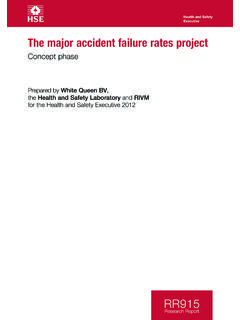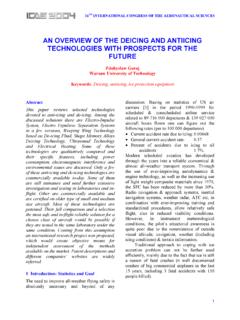Transcription of Financial position of public-sector institutions
1 938 Financial position of public - sector institutions In brief State-owned companies are expected to invest R362 billion in infrastructure over the medium term, contributing significantly to gross capital formation. Development finance institutions will lend a projected R44 billion over the next two years, with a focus on energy and green-economy projects. The surplus and deficit positions of the social security funds reflect the build-up of fiscal imbalances that will be addressed over the medium term. Government intends to exercise greater oversight over public institutions , and will over time optimise its portfolio of institutions to strengthen national development. Overview his chapter reviews the Financial position of South Africa s major public - sector institutions .
2 State-owned companies are large contributors to economic activity, accounting for 20 per cent of gross capital formation. Development finance institutions have rapidly expanded their lending in recent years. The social security funds provide compensation or income support for workers and road users who are out of work or injured, and the Government Employees Pension Fund provides income security to more than 1 million state workers. Most of these institutions operate independently of the budget; fiscal allocations are not their primary source of revenue. However, their operations and Financial positions must be taken into account in government s budget planning, since they have important consequences for the public finances over the long term.
3 Well-managed public - sector assets can promote economic growth and social development. Where these assets are not performing well, however, T State-owned companies account for 20 per cent of capital formation 2015 BUDGET REVIEW 94they can materially affect the broader public finances and become a drag on economic progress. Financial health and national development Table shows the consolidated Financial position of selected categories of public - sector institutions . Despite subdued GDP growth over the past five years, all major categories of these institutions have experienced significant asset growth since 2010/11. Two factors account for most of this growth: infrastructure investments by state-owned companies and the expanded loan books of development finance institutions .
4 Many public institutions are in a strong Financial position , contributing simultaneously to fiscal sustainability and public welfare. In recent years, however, the Financial and operational performance of several state-owned companies and development finance institutions has weakened. And although the overall Financial position of the social security funds is strong, liabilities continue to mount at the Road Accident Fund (RAF). Inadequate policy frameworks, regulatory uncertainty, poor operational performance and governance failures often lie behind the deterioration in Financial positions. Weak Financial performance is also frequently associated with a failure to define clear strategic goals.
5 Where an unsustainable Financial position is not addressed, public institutions often turn to government to provide a lifeline using public funds. Unless underlying imbalances are resolved, however, such interventions are at odds with sustainable public finances. Table Combined Financial position of selected categories of public institutions , 2010/11 2013/14R billion2010/11 2011/12 2012/13 2013/14 State-ow ned com paniesTotal as s Total Net asset De ve lopm e nt finance ins titutionsTotal as s Total Net asset Social s e curity fundsTotal as s Total Net asset value Other public entities1 Total as s Total Net asset 1.
6 State-owned institutions without a commercial mandate and listed in either schedule 1 or 3 of the Pub lic Finance Management Act (1999) such as National Lib rary of South AfricaSource: National TreasuryState-owned companies and development finance institutions have seen large asset growth in recent years While many institutions are in a strong Financial position , several face serious shortfalls CHAPTER 8: Financial position OF public - sector institutions 95 Given current fiscal constraints, government will address the funding needs of public institutions in a manner that does not increase the budget deficit. The sources of such funds can include the disposal of non-strategic assets such as property, direct and indirect shareholdings in listed firms, non-strategic shareholdings in state-owned companies and surplus cash balances in public entities.
7 Such asset sales will take place only as funding is required or where there is clear strategic benefit to the state. In some cases, such as the RAF, additional funding could be provided from increased taxes or levies. Where government support is provided in the form of funding or guarantees, public entities will be required to demonstrate sound business plans, strengthen internal governance and improve operational performance. Close monitoring will take place to promote efficient delivery on government priorities, simultaneously improving commercial performance and ensuring that government can meet its fiscal targets. Over the longer term, reforms to governance and policy frameworks are required.
8 In 2011 the Presidency commissioned a review to assess how well state-owned entities executed their mandates. The 2015 Cabinet Lekgotla considered the review and its recommendations to improve the contribution of these entities to national development. Key interventions under consideration include: Establishing an inter-ministerial committee to improve alignment and coordination between entities. Identifying those state-owned companies that are integral to national development, and setting out an approach to acquiring and disposing of public assets based on strategic requirements. Introducing overarching legislation to govern these entities. Costing developmental mandates more explicitly, with the Financial implications set out more clearly in shareholder compacts.
9 Exploring options for private investment to strengthen balance sheets, and creating opportunities for private investment in sectors dominated by state-owned companies. An example of this approach is the successful Renewable Energy Independent Power Producers Procurement Programme. State-owned companies Since 2008/09, state-owned companies have made large capital investments in energy, transport and logistics to expand the productive capacity of the economy. Over the next three years, investment in these sectors will continue to dominate capital formation by the public sector . Over the medium-term expenditure framework (MTEF) period, state-owned companies project capital expenditure of billion, with Eskom, Transnet and the South African National Roads Agency Limited (SANRAL), accounting for most of this expenditure.
10 Details on infrastructure spending appear in Annexure B. Table shows the capital expenditure of state-owned companies with the largest investment programmes. Where government support is required, it will not be provided in a way that increases the budget deficit Government is considering overarching legislation for state-owned entities Over the next three years, state-owned companies project capital expenditure of billion 2015 BUDGET REVIEW 96 The major state-owned companies improved their capital spending over the past two Financial years, spending 98 per cent of their 2013/14 budgets, compared with 80 per cent in 2012/13. Expanded infrastructure investments have led to a steady increase in the asset base of state-owned companies, from billion in 2009/10 to billion at the end of 2013/14.

















